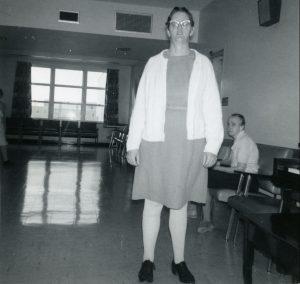 Components: Self-Guided 2 – Doreen Befus Story
Components: Self-Guided 2 – Doreen Befus Story
Timing: 30 Minutes
Mode: In-class; Online

It is very difficult to uncover the voices and perspectives of the targets of eugenics legislation, but this set of resources shifts the focus from the political to the personal. A selection of the letters and photographs that Doreen Befus donated to the Red Deer and District Archives are also included here with audio commentary by Claudia Malacrida and Erika Dyck, allowing students the rare opportunity of appreciating the motivations and experiences of one victim of eugenicist policy.
Doreen Befus’ life also intersected with the history of deinstitutionalization. In the 1960s and 1970s, new notions of the value of community living, coupled with legal and financial pressures, resulted in a period of massive deinstitutionalization across Canada. Many psychiatric hospitals and institutions like the Michener Centre closed down, the number of available beds was reduced, and many former patients and inmates of such institutions were released into their communities. Befus moved to community living, then to her own apartment, emerging as an advocate and an activist.

Befus’ story makes crystal clear the utter inadequacy of medical labels. Doreen Befus was a caregiver, an activist, a writer, a friend, a sister and an aunt. The medical label of “moron,” however, overshadowed these more important designations for most of her life.
Students can work through this material online or in class. These self-guided resources are well suited for flipped classroom use with an in class or online discussion or learning activity.
Ask students to use the following questions to guide their exploration of these components:
- What are the possible consequences of professional practice that negates individual autonomy and agency?
- What does Befus’ story tell us about the importance of seeing beyond diagnostic labels?
- How did the victims of these laws and procedures understand their experience, and how did the institutional context in which most of these operations took place shape patients’ understandings of the procedures?
- How did Befus and other sterilization victims come to terms with their new reproductive limitations?
Listen to Claudia Malacrida describe what she uncovered from her interviews of people who lived in Michener Centre (formerly the Provincial Training School).
Erika Dyck has studied and written about Doreen Befus as a very interesting case study on the topic of sterilization, eugenics, deinstitutionalization and activism.
Listen to Erika Dyck give some biographical context to Doreen’s story.
In 1976, as part of the broader shift away from institutional living, Befus moved out of Deerhome institution, and into the community of Red Deer. But Befus’ story reveals how many people like her were unprepared for such independence. Listen to Erika Dyck explain how Doreen’s history of institutionalization affected her life and activism outside of the institution.

Befus’ experiences of institutionalization, deinstitutionalization and sterilization helped to shape the kind of activism she engaged in once she was living on her own. Explore some of the letters she wrote on the subject of institutions.
Download and read Doreen’s 1980 letter to the Alberta Association for the Mentally Retarded, which explains her perspective on institutions for “mentally handicapped” individuals. Transcription.
Download and read Befus’ 1980 letter to Phoenix Rising Magazine, in which she expresses her concern over the “unfair” conditions in institutions like Michener Centre and her frustrations regarding the apparent lack of government interest in, and the clear lack of funding for, these institutions. Transcription.
Despite all the records that Befus kept (and later donated to the Red Deer Archives) we know very little about her thoughts on sterilization. One letter, written by Befus to Leilani Muir’s lawyer, provides us with some clues, however. Leilani Muir successfully sued the Alberta government for wrongful sterilization in 1995. Her particular kind of activism, shaped by her experience of institutionalization and deinstitutionalization, also seems to have given shape to her opinions on sterilization. Befus expresses some of these opinions in this 1993 letter to lawyer Sandra Anderson.
Download and read Doreen’s Letter to Leilani Muir’s Lawyer (1993). Transcription.
Listen to Erika Dyck’s interpretation of Befus’ response to lawyer Sandra Anderson and her stance on the sterilization lawsuits that were emerging in the 1990s.
How can we interpret Befus’ stance on sterilization? Listen to Erika Dyck comment on how Befus’ life story helps us to understand her acceptance of her reproductive fate.


 Français
Français